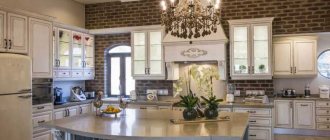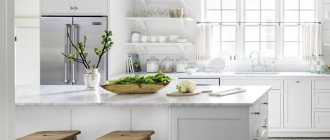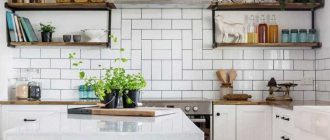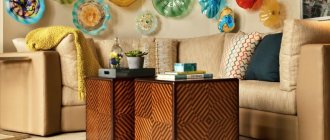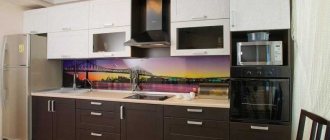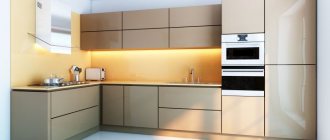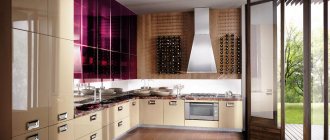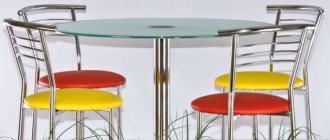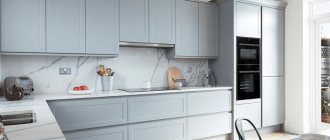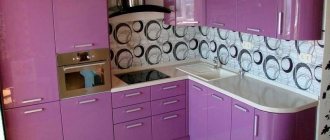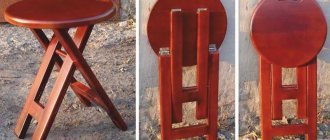Details of cabinet furniture and their names
The main details of cabinet furniture are quite easy to remember, the names of the furniture parts speak for themselves, these are the sides, bottom, lid or tabletop, back wall, drawer or plinth, and in some cases shelves, doors, also known as facades, drawers, dryers, handrails and things like that.
The parts are divided into two main types: the first type is the parts that form the furniture frame, the second type is those furniture parts that are installed directly on the already assembled frame. As an example, let's look at what parts a kitchen table consists of. The parts that form the frame of the furniture in this case are the sidewalls (No. 1), the back wall (No. 2), the drawer or base (No. 3) and the bottom (No. 4), it is also worth noting the important role of the tabletop (not shown in the figure) in this design it must be rigidly fixed either to dowels or to corners. In our case, the additional parts installed on the assembled furniture frame are the remaining doors (no. 5), shelves (no. 7) and drawers (no. 6).
And, by the way, if the desire to acquire new furniture is due only to the desire to update the kitchen, although the old one is functionally satisfactory, it’s probably worth thinking about changing only the hanging parts of the facades, handles and other things. Functionality is another matter - here it’s worth thinking about a complete remodel or adding some furniture elements.
Let's return to the topic of frame furniture details and consider the features of each of them.
Detail of cabinet furniture - Sidewall.
The length and width of the sidewall determine the height and depth of your table, and while you can experiment with depth, an incorrectly selected table height can make it extremely uncomfortable. Among the design features, it is worth noting the need to cut off the corner in the far lower corner of the sidewall, otherwise the table will rest against the baseboard, which will not allow you to move the table close to the wall.
Detail of cabinet furniture - Back wall.
Typically made from fiberboard or treated fiberboard. The width of the back wall is made three millimeters less than the width of the table and, when fastening, they retreat approximately one and a half millimeters on each side. The height of the back wall of the kitchen table should also be shorter, but by 1 - 2 millimeters from the edge of the bottom to the tabletop (there is no need to cover the space behind the console with the back wall). In the lower part you also retreat from the edge of the bottom, but in the upper part it is advisable to make it flush with the sides. The back wall is attached to the furniture parts using ordinary small nails (like post nails), take my word for it - this fastening is enough.
Detail of cabinet furniture - drawer, console.
In most cases, the height of this part is approximately 10 cm. This size of the furniture is due to the fact that the drawer, together with the back wall, prevents our structure from diagonal deformation (in other words, it does not allow it to fall on its side). The width of the console is equal to the width of the table minus the thickness of the two sides. The console is attached tightly between the sidewalls; it is advisable to use Confirmat furniture screed for fastening. In many designs, the drawer is installed flush with the doors, which in my opinion is wrong because when approaching the table you will constantly rub your shoes against the drawer, so it is worth recessing it somewhat inside the table. Installing a drawer at the bottom of the table is traditional, but not at all necessary, so the following figure shows the use of a drawer in place of the console, which can either be attached to the sides or have its own wheels; in the latter case, it is possible to store heavier things or, for example, potatoes. The console in this design is installed at the top of the table.
Detail of cabinet furniture - bottom.
The detail is simple but irreplaceable. The dimensions of the bottom correspond to the depth of the table and the width minus the thickness of the two sides. The bottom is tightly fastened between the sidewalls; it is advisable to use Confirmat furniture screed for fastening.
Details of cabinet furniture - doors.
Doors, or facades, are a separate big topic that we will talk about next time. In this case, we will only touch on the dimensions of the door. The width of the door corresponds to half the width of the table minus five millimeters. (4 millimeters on the edges (2 mm on each side) and one millimeter on each door for the gap between them). The height of the door depends on the presence of drawers in the design, in the presence of which it is necessary to take into account a gap of 2 millimeters with the mating parts of the furniture.
Details of cabinet furniture - drawers and shelves.
Everything is simple with the shelves; their size corresponds to the size of the bottom. It is advisable to attach it to corners, furniture dowel dowels or special holders for shelves. Boxes are a kind of separate design and therefore we will devote a separate topic to them.
In this case, we have not considered all the details of cabinet furniture, but only the main ones, which I hope will be enough to assemble furniture with your own hands for your home and garden.
Source: ptexpert.ru
Name of furniture parts
After reading this text, you will easily understand the instructions for assembling furniture. Moreover, a picture of the assembly diagram will immediately form in your imagination. This will increase your productivity several times and minimize the risk of errors.
But, before listing the list, let's look at the name of the cabinet furniture modules. Remember that the section that hangs on the wall is called a cabinet. The section that stands on the floor is called a cabinet. Drawers in furniture are only retractable.
Brief outline of the history of furniture development
Buffet (French) – a cabinet for storing dishes, table linen, snacks, drinks.
Bureau (French) - a type of desk with a retractable lid and drawers for storing papers. Depending on the purpose, there are office bureaus, supplier bureaus, secretary bureaus, and closet bureaus.
Hanger - a shelf or rack with hooks or pegs (as well as a separate hook) for hanging dresses and hats.
Showcase (French) – a glazed box, cabinet for displaying museum exhibits.
Wardrobe (French) – a wardrobe for clothes.
Sofa (pers.) – a type of furniture of large size, soft, semi-soft and hard, for sitting and lying.
Furniture dowel
This type of fastening is rarely used on its own in the modern furniture industry. It is mainly used only to impart rigidity in conjunction with eccentric couplers.
Its main function in most cases of furniture construction is to prevent the panels from moving relative to each other and giving additional rigidity to the fastening.
Usually used in conjunction with an eccentric coupler. It is made from hard natural wood and has a cylindrical shape. This is a very simple and cheap part that has been used in wooden joints since time immemorial.
Craftsmen and carpenters who work with wood use furniture dowels as the main fastening element. In this case, the furniture parts are connected to dowels, which are glued to the parts using PVA glue. In this case, using any other screeds together with PVA no longer makes sense.
Dictionary of classical cuisine: getting acquainted with decorative elements
The classical style originated many centuries ago in the homes of noblemen. This is perhaps the most intricate style possible. It is possible that this is why it does not lose its popularity. What decorative elements does a classic-style kitchen not contain? Let's try to understand all their diversity and learn to distinguish a boiserie from a balustrade.
So, everything in order. As is customary in any dictionary, we will go alphabetically. And the first letter in our kitchen dictionary is “B”.
Balustrade
- This is a fence for stairs and furniture, consisting of figured posts connected at the top by a bar. In the kitchen, elegant balustrades provide security and decorate the interior. This decorative element gives an elegant charm to the interior and completes the unique image of the entire space. However, the kitchen balustrade contains not only decorative, but also functional features. For example, it organizes additional space in the kitchen and prevents various items from rolling off the shelves.
Boiserie
— translated from French as “wood paneling.” Today, this term is used by professionals to refer to wooden wall panels. What is their advantage? Wood is a healthy, environmentally friendly, hypoallergenic material that provides high heat and sound insulation. And also durable: with proper care, boiserie panels can last up to a hundred years.
Boiserie varies in color, texture, shape and size and fits perfectly into a classic interior: wood paneling is done from floor to ceiling. For an interesting and high-quality design of classic kitchen sets, boiserie is used, for example, as aprons or as separate interior elements that complement the overall look. Such decorative elements allow you not only to decorate the room, but also to protect walls and kitchen furniture from soot and splashes.
Cornice
– the final element of kitchen furniture. Being at the very top, we act as a kind of “crown”.
Column
- a pillar, most often cylindrical in shape, but not necessarily. There are also square ones. This is a support element; in a classic kitchen set it often supports a cornice or countertop.
Patina
- a natural phenomenon to which metal and wood are exposed in natural conditions. This is a kind of aging when cracks and darkening appear on the material, and the colors become brighter. This technique began to be used in the furniture industry and artificially aged the material. This kind of decoration of facades creates a patina of time, while the kitchen looks antique and therefore expensive.
Pilaster
- a symbol for a column or semi-column, distinguished from them by the absence of entasis (thickening of the trunk). They have one rear plane, which is attached to the elements of the furniture structure. Their front plane can be oval, figured, decorated with various three-dimensional patterns. In a classic kitchen it acts as a decorative element, giving the furniture a luxury and noble look.
Portal
- this is a kind of superstructure over the hob, where, as a rule, the hood is located; it is placed in the center of the composition. A kitchen with a portal takes on a special quality and presentability. Of course, this element serves as a decoration and emphasizes the classic style of the entire kitchen. However, in addition to aesthetics, it also brings functionality.
The kitchen portal area includes a hob and an extractor hood, so the kitchen receives a dedicated area for cooking. Also, in such an add-on you can very effectively organize lighting for the work area. The most difficult thing is to harmoniously fit modern appliances into a classic interior, and the portal helps to hide the hood. The big advantage is also that due to it you can significantly increase the working space of the headset by designing all kinds of working boxes and shelves above it - so much useful in just one element!
Base
- the lower part of the kitchen, most often recessed inside.
We introduced you to the basic elements of decorating a classic kitchen. As you can see, they are so diverse and yet they all fit perfectly together, making the kitchen more noble and luxurious. At the same time, many elements bring not only external beauty, but also internal functionality. For those who appreciate elegant splendor and refined taste, but at the same time do not forget about the purpose of the space, this kitchen is an ideal option!
Author: MF Maria
Screw tie
The screw coupler consists of a screw and a barrel. This kit is used to attach the end of one panel to the face of another. For example, for attaching a shelf to a side panel or a headboard to the drawers.
This is a very strong fastening due to the large tightening stroke. The only drawback of this fastener is that the screw head is visible from the front of the panel.
You can, of course, close them with special plugs, but this is also not a panacea. The plugs on the outer panel of the cabinet do not look aesthetically pleasing.
Installation of this type of fastener requires skills. Beginners may encounter such a problem as inaccurate alignment of the barrel holes with the hole in the end of the shelf, and it is not so easy to remove the unwanted barrel from its nest.
But the inconvenience during assembly and aesthetic errors are more than compensated for by the reliability and durability of the connection.
Conical coupler
The conical tie is often used for fastening thick chipboard panels (25 mm, 38 mm) and assembling frame facades on tie bars.
One of its advantages is the absence of visible caps on the front side of the panels. Unlike the screw in a screw tie, the rod used in a tapered tie is screwed into the panel. The screed itself has 2 holes. One is for the rod, which is screwed into the panel layer. The second is for the conical tie screw. The disadvantage of this type of fastener is the small tightening stroke. Under heavy loads, the holes for the rod screw may become loose over time. Then the screed will simply stop working!
Euroscrew
This fastener is often used for assembling kitchen furniture modules and in economy class furniture. Just like with a screw tie, Euroscrew heads or plugs are visible on the front side of the side panel of the cabinet.
It screws into the end of the shelf with a pre-drilled hole. This screed also belongs to the economy class. To install it, 2 holes are drilled - into the end of the shelf and into the face of the part. They are attached perpendicular to each other. The most commonly used euroscrews are 7 mm in diameter and 50 or 70 mm in length.
This screed has 2 significant drawbacks:
Firstly, the outer side of the cabinet, if there are many shelves behind it, as a rule, is all “disfigured” with caps or Euroscrew plugs. Therefore, these fasteners are used in economy furniture. In kitchens, this drawback is hidden thanks to the cabinets standing in a row.
Secondly, furniture assembled with euroscrews cannot be disassembled and reassembled more than 3 times, since screwing the tie into the end of the shelf destroys its internal structure.
Name of parts
1. The upper horizon is the topmost part in wall cabinets, located horizontally, at right angles to the sides. It differs from a shelf in that it is always located at the top of the module when the shelf is inside.
2. The lower horizon is the lowest part in wall cabinets, located horizontally, at right angles to the sidewalls. It differs from a shelf in that it is always located at the bottom of the module when the shelf is inside.
3. The sidewall is the outermost side part, located vertically, at right angles to the horizons and shelves.
4. Planks are narrow (minimum width 60 mm) parts located in the upper part of the structure, between the sidewalls. Designed for hidden fastening of lids and table tops.
5. Removable shelves are recessed horizontal parts that are not fixed inside the section.
6. Shelves are rigid recessed parts located horizontally inside the section.
7. The bottom is the lower horizontal part in the design of the cabinet.
8. The base is the lowest recessed part, located horizontally with an edge, under the bottom. Removable is designed to hide the legs. The rigid base acts as a drawer.
9. The drawer is a part located horizontally with an edge under the tabletop or rigid shelf, between the sidewalls. Designed to prevent sagging of the part lying on it.
10. The back wall is the part that covers the cabinet or cabinet from the back. Mainly made of fiberboard or HDF.
12. The facade is the front decorative panel, in other words, the door of a cabinet or cabinet.
13. Sheflot is the front of a drawer
14. A tabletop is the working area of a table or kitchen unit.
Conclusion
Now you know the name of the parts. They serve as building blocks for cabinet furniture. This knowledge is guaranteed to help you when making furniture with your own hands. Correct me in the comments if I missed anything.
If you need detailing of cabinet or built-in furniture, please contact us. We will definitely discuss the terms of cooperation and come to a common opinion. For a moderate percentage of my work, I will prepare a detailed project for you on time.
What would you like to add to this article?
Tell me about your experience in the comments.
I will be very interested to hear your stories!
With good thoughts about you, always in sawdust
Rekun Dmitry.
Don't forget to share this article on social networks
Click here to find out more:
Eccentric coupler
One of the most popular types of fasteners today. All high-quality furniture is assembled on an eccentric screed (minifix). Its operating principle is as follows: an eccentric rod is screwed into the face of the part to which another panel will be attached at the end, into which the eccentric itself is screwed through the end of the other shelf, and then the eccentric turns the rod into itself.
An eccentric tie is always used in conjunction with a wooden dowel, which was described earlier. The dowel provides additional rigidity to the assembly and prevents the fixed panels from moving relative to each other.
Furniture assembled on this screed can be disassembled and assembled an unlimited number of times! There are different diameters of the eccentric itself: 25, 15, 12 mm. More common is an eccentric with a diameter of 15 mm.
Since the eccentric itself is visible on the side panel, plugs are provided for it to match the color of the panel. One of the disadvantages is the weakening of the tie in the event of spontaneous rotation of the eccentric.
To avoid this, some hardware manufacturers have provided notches directed in the opposite direction from its rotation during installation, which enhances adhesion.
Types of eccentric couplers
As practice shows, furniture is assembled and disassembled with great difficulty if all the fasteners in it are metal ties, described above. Let’s say that in order to remove one shelf, you practically need to disassemble half the cabinet. For horizontal parts (shelves), it is more convenient to use eccentrics, which allow you to place horizontal parts in an already assembled furniture box. Their operating principle is the same as that of the previously described eccentric coupler.
The only difference is that the eccentric, located in the shelf, fits onto the rod screwed into the face of the sidewall from above and there is no need to disassemble half the cabinet for this. In some factories, this type of fastener is called a shelf holder, since it is intended only for horizontal parts. Horizontal shelves assembled using these ties further tighten the joint, which increases the rigidity of the entire furniture frame.
Repeated dismantling and installation of furniture on such fasteners does not lead to wear of the connections.
Source: dd-space.com
Name of parts
1. The upper horizon is the topmost part in wall cabinets, located horizontally, at right angles to the sides. It differs from a shelf in that it is always located at the top of the module when the shelf is inside.
2. The lower horizon is the lowest part in wall cabinets, located horizontally, at right angles to the sidewalls. It differs from a shelf in that it is always located at the bottom of the module when the shelf is inside.
3. The sidewall is the outermost side part, located vertically, at right angles to the horizons and shelves.
4. Planks are narrow (minimum width 60 mm) parts located in the upper part of the structure, between the sidewalls. Designed for hidden fastening of lids and table tops.
5. Removable shelves are recessed horizontal parts that are not fixed inside the section.
6. Shelves are rigid recessed parts located horizontally inside the section.
7. The bottom is the lower horizontal part in the design of the cabinet.
8. The base is the lowest recessed part, located horizontally with an edge, under the bottom. Removable is designed to hide the legs. The rigid base acts as a drawer.
9. The drawer is a part located horizontally with an edge under the tabletop or rigid shelf, between the sidewalls. Designed to prevent sagging of the part lying on it.
10. The back wall is the part that covers the cabinet or cabinet from the back. Mainly made of fiberboard or HDF.
12. The facade is the front decorative panel, in other words, the door of a cabinet or cabinet.
13. Sheflot is the front of a drawer
14. A tabletop is the working area of a table or kitchen unit.
Conclusion
Now you know the name of the parts. They serve as building blocks for cabinet furniture. This knowledge is guaranteed to help you when making furniture with your own hands. Correct me in the comments if I missed anything.
If you need detailing of cabinet or built-in furniture, please contact us. We will definitely discuss the terms of cooperation and come to a common opinion. For a moderate percentage of my work, I will prepare a detailed project for you on time.
What would you like to add to this article?
Tell me about your experience in the comments.
I will be very interested to hear your stories!
With good thoughts about you, always in sawdust
Rekun Dmitry.
Don't forget to share this article on social networks
Doors
Cabinet sliding wardrobes are equipped with sliding sliding panels in the front part. Such designs are convenient in small rooms to save space. Owners of modern spacious apartments prefer to build wardrobes along the entire wall. In this case, a continuous facade of a large area is formed.
A free-standing wardrobe or china cabinet is equipped with hinged doors. The part is intended to protect the internal contents and for decorative purposes. Door fasteners are selected depending on the type: hinged hinges or roller guides.
Facade
As a rule, wardrobe doors form the entire façade of the furniture. Other design solutions for the facade also include:
- fragments of decorative glazing;
- edges of open shelves;
- sheflots (front parts of drawers);
- decorative overlays (horizontal and vertical);
- cornices.
The concept of “façade” includes all visible elements extending into the side or frontal plane. The material, color and texture of the facade sets the style of the interior. It is possible to make sliding wardrobes from ready-made facades, which are sold in a wide range.
Thank you. It was interesting to expand my horizons.
Didn't they say what a sidewall is?
Hint: The word sidewall comes from the word side. Accordingly, the sidewall is...Ask your child, I’m interested in whether he can guess it or not. And tell me later.
Thanks for the useful information. I found out that the front on the drawer is put on Sheflot.
Live and learn!
Leave a comment Cancel reply
This site uses Akismet to reduce spam. Find out how your comment data is processed.
Back wall
The back wall covers the product from the back. The materials used are durable boards without decorative finishing: chipboard, HDF, DFPO.
If you need a service for making custom-made furniture in Moscow, you can contact our company. The website contains numerous photographs of models that we will produce according to individual sizes. We offer competitive prices for materials, fittings and work. The surveyor's visit is free.
Source: www.shkaflon.ru
Accessories
Furniture fittings are all kinds of fasteners, handles, curtains, supports and decorative elements. They are made of metal, wood, plastic and other materials. Metal products are treated with special anti-corrosion agents to extend their service life. For luxury-class designs, the fittings can be gold-plated or silver-plated, as well as trimmed with rhinestones, crystal or natural stones. Conventionally, fittings can be classified by type.
Connecting fittings – connects and fixes parts together. This group includes one-piece, detachable and movable elements:
- Permanent connections include screws, ties, screws, nails, bolts, brackets, hooks, upholstery buttons of upholstered furniture. The tie can be eccentric or connecting. Galvanized steel is used for the eccentric tie and makes it durable. The corner tie does not require additional holes in the ends of the furniture. Threaded ties include a nut and a screw that create a strong connection. A wedge coupler is also used for quick connection. It is based on plates, wedges and staples. The ties are connected with traditional screws;
- Detachable connections ─ these are door handles, latches, shelf holders, magnetic devices, locks, bolts. To fasten detachable structures, screws and self-tapping screws are used;
- Movable ─ these are hinges, “rails” for parallel movement of the door, microlifts. Pneumatic mechanisms and ball-bearing guides take on the entire load.
For furniture made from chipboards, it is not recommended to use piano hinges, which were used several decades ago. Today, manufacturers use four-joint designs called "frog". They can withstand a 10,000th door opening/closing cycle.
Rotating elements ─ these include carousel mechanisms, structures for moving tabletops apart, for directing the movement of products. For example, the shelf rotates along its axis and makes it easy to get the desired item. Basically, furniture structures are built using guide systems, which are used to pull out elements. They can extend fully or partially. Thanks to special rollers, such systems operate smoothly and almost silently. They are made of steel, fluoroplastic or duralumin. If we consider the importance of fittings as a percentage of the cost of cabinet, upholstered and kitchen furniture, we get the following results: in cabinet furniture, fittings account for 10-15% of the total cost of the product. For a kitchen, the importance of fittings is 25% of the cost of the set, and for upholstered furniture it is 30-40% of the cost of the product.
Accessories for assembly ─ when purchasing furniture, you need to pay attention to the accessories and upholstery fabric, determine their quality and strength. And also on the assembly details of the product, which include furniture corners, confirmants, rafixes, minifixes and dowels:
- Furniture corners are simple, cheap and affordable types of connections. On the construction market they are presented in different sizes, made of plastic and metal. Corners are designed for fastening hinged parts in pencil cases and cabinets. They are easy to install, have a low price, but are noticeable, which slightly spoils the design of the structure;
- Confirmat is a furniture European screw, which received its name from the German manufacturer. A furniture screw tie, consisting of a steel rod with a blunt ring, a head and a massive thread, is capable of connecting several wooden elements at once. The confirmation is visible in the design, so it is masked with a plug. The most common are screws with dimensions of 7x50 mm or 6.3x50 mm;
- A dowel is a connecting element that is used for assembling wooden, plywood, and chipboard furniture parts. It is made of hardwood and has a cylindrical shape with chamfers. Today plastic dowels are also produced. They strengthen furniture connections with confirmat, minifix and rafix. Used with PVA glue as an independent fastening element;
- Minifix ─ is an eccentric coupler for furniture joints, consisting of two parts ─ a rod and an eccentric. Minifix has a different design, which makes it possible to increase the length of the element and connect it at different angles. For installation, use a Ø15 mm cutter and drills, with which three holes are drilled. The fastening turns out to be complex and requires precise calculation;
- Rafix ─ is used in visible places to connect furniture parts of tabletops, side parts of furniture structures. It is installed on two holes, has an eccentric mechanism and a rod. Rafix has a beautiful aesthetic appearance, but it is not particularly durable.
Source: mblx.ru
What are the furniture parts called?
Cabinet furniture - what is it? What is hidden behind this capacious concept? What should it be like to bring us joy and comfort? To begin with, the definition: this is furniture consisting of separate rigid parts. In other words, cabinet furniture is cabinets, tables, benches, chests of drawers, shelving, dressing table, cabinets. Sofas, for example, cannot be classified as cabinet furniture - since their main part is a soft mattress and a backrest. So, we figured out the key concept. Further more. Cabinet furniture today is made from a wide variety of materials. In addition to the notorious chipboard (chipboard), manufacturers also use solid wood - beech, hornbeam, walnut, pine and other conifers, oak. In addition to wood and its derivatives, metal and glass are also used in production - advanced materials that are gaining increasing respect and demand among consumers - both for the office and for the home. Almost everything is made from steel and glass today - coffee tables, computer tables, desks, cabinets, shelving. The finishing materials used are plastic, the same metal and glass, as well as wood. Depending on where you purchase the furniture, the material and design style are determined.
In offices, cabinet furniture should first of all be representative - if the office often hosts presentations and meetings. After all, the lion's share of the impression from the enterprise is given by correctly selected cabinet furniture. It is very fashionable to furnish an office in the Art Nouveau style - modern shapes and colors. The predominant materials for the production of such furniture are chipboard and metal. Office cabinet furniture is usually distinguished by its simplicity of shape, clear lines and restraint in colors. The strength characteristics should also be an order of magnitude higher, because office furniture is subject to significant operational loads. The style decision here is also not in last place, but it should be more strict, set in a businesslike mood, and maintain a working atmosphere. Expensive materials and fittings are appropriate only in executive offices, where cabinet furniture also performs representative functions.
For the home, cabinet furniture must be selected based solely on the tastes of the owners. Furniture of a wide variety of styles can be found in almost any design - from solid wood, metal, and chipboard. What your home will be like is up to you. In a home interior, beauty and elegance combined with maximum functionality and harmony of shapes and colors are more important than increased wear resistance of surfaces. Here it is necessary that cabinet furniture best suits the tastes of the owners and the style of the interior as a whole. Its direct purpose is to create coziness in the house, to be roomy and comfortable.
